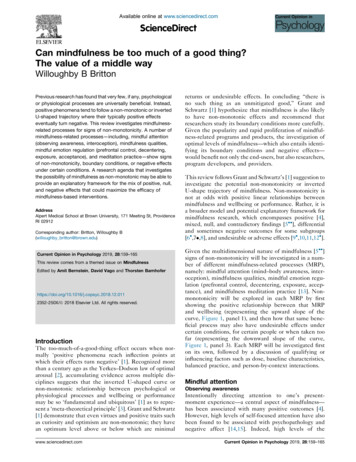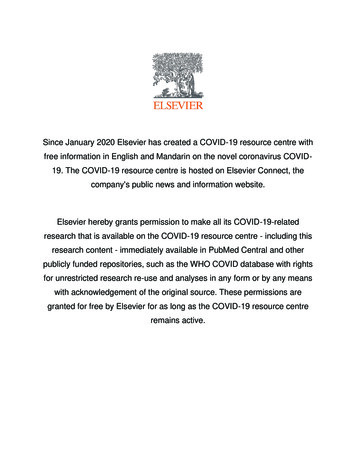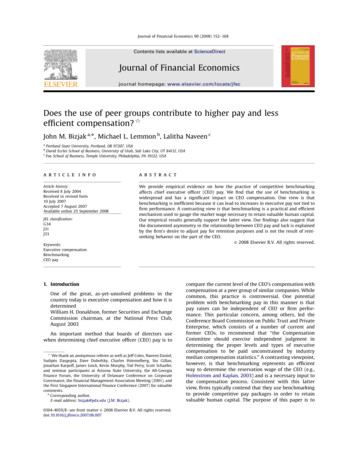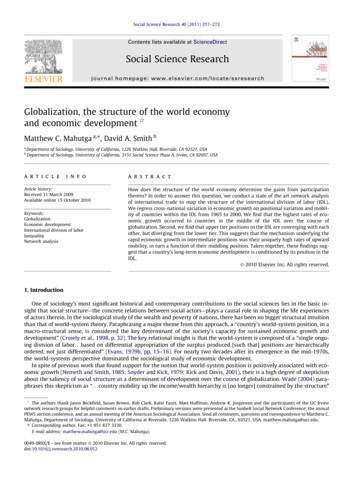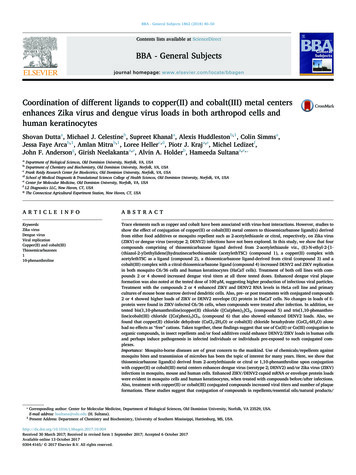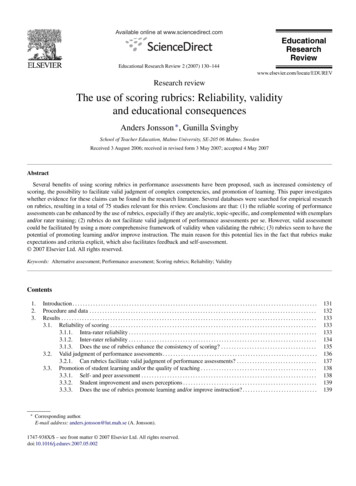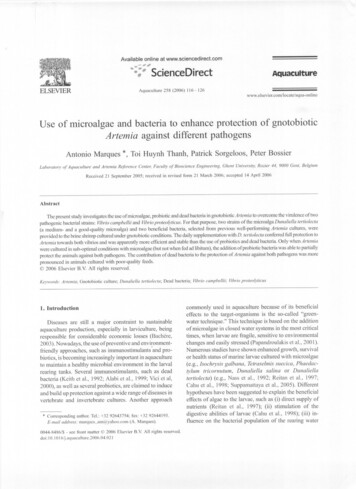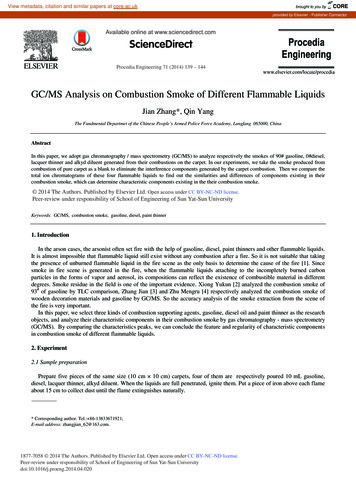
Transcription
View metadata, citation and similar papers at core.ac.ukbrought to you byCOREprovided by Elsevier - Publisher ConnectorAvailable online at www.sciencedirect.comScienceDirectProcedia Engineering 71 (2014) 139 – 144GC/MS Analysis on Combustion Smoke of Different Flammable LiquidsJian Zhang*, Qin YangThe Fundmental Departmet of the Chinese People’s Armed Police Force Academy, Langfang 065000, ChinaAbstractIn this paper, we adopt gas chromatography / mass spectrometry (GC/MS) to analyze respectively the smokes of 90# gasoline, 0#diesel,lacquer thinner and alkyd diluent generated from their combustions on the carpet. In our experiments, we take the smoke produced fromcombustion of pure carpet as a blank to eliminate the interference components generated by the carpet combustion. Then we compare thetotal ion chromatograms of these four flammable liquids to find out the similarities and differences of components existing in theircombustion smoke, which can determine characteristic components existing in the their combustion smoke. 2014 The Authors. Published by Elsevier Ltd. Open access under CC BY-NC-ND license. 2014 The Authors. Published by Elsevier Ltd. Selection and peer-review under responsibility of the Academic CommitteePeer-review under responsibility of School of Engineering of Sun Yat-Sun Universityof ICPFFPE 2013.Keywords: GC/MS, combustion smoke, gasoline, diesel, paint thinner1. IntroductionIn the arson cases, the arsonist often set fire with the help of gasoline, diesel, paint thinners and other flammable liquids.It is almost impossible that flammable liquid still exist without any combustion after a fire. So it is not suitable that takingthe presence of unburned flammable liquid in the fire scene as the only basis to determine the cause of the fire [1]. Sincesmoke in fire scene is generated in the fire, when the flammable liquids attaching to the incompletely burned carbonparticles in the forms of vapor and aerosol, its compositions can reflect the existence of combustible material in differentdegrees. Smoke residue in the field is one of the important evidence. Xiong Yukun [2] analyzed the combustion smoke of93# of gasoline by TLC comparison, Zhang Jian [3] and Zhu Mengru [4] respectively analyzed the combustion smoke ofwooden decoration materials and gasoline by GC/MS. So the accuracy analysis of the smoke extraction from the scene ofthe fire is very important.In this paper, we select three kinds of combustion supporting agents, gasoline, diesel oil and paint thinner as the researchobjects, and analyze their characteristic components in their combustion smoke by gas chromatography - mass spectrometry(GC/MS). By comparing the characteristics peaks, we can conclude the feature and regularity of characteristic componentsin combustion smoke of different flammable liquids.2. Experiment2.1 Sample preparationPrepare five pieces of the same size (10 cm 10 cm) carpets, four of them are respectively poured 10 mL gasoline,diesel, lacquer thinner, alkyd diluent. When the liquids are full penetrated, ignite them. Put a piece of iron above each flameabout 15 cm to collect dust until the flame extinguishes naturally.* Corresponding author. Tel.: 86-13833671921;E-mail address: zhangjian 62@163.com.1877-7058 2014 The Authors. Published by Elsevier Ltd. Open access under CC BY-NC-ND license.Peer-review under responsibility of School of Engineering of Sun Yat-Sun Universitydoi:10.1016/j.proeng.2014.04.020
140Jian Zhang and Qin Yang / Procedia Engineering 71 (2014) 139 – 144Through retrieval in G1033 As, D.01.00 NIST'02 standard mass spectrum database, the nomenclature, chemical formula,molecular weight and retention time of corresponding components to the characteristic peak have been recorded. 11characteristic peak have been found in the total ion chromatogram of Sample 2(smoke produced by combustion of gasolineon the carpet), and 9 characteristic peaks for Sample 3 (smoke produced by combustion of diesel on the carpet), 8characteristic peaks for Sample 4 (smoke produced by combustion of lacquer thinner on the carpet), 9 characteristic peaksfor Sample 5 (smoke produced by combustion of alkyd diluent on the carpet).Table 1. Sample numbercombustionsupporting agentsblankgasolinediesellacquer thinneralkyd diluentsamplesample 1sample 2sample 3sample 4sample 52.1. GC/MSD analysis conditionsChromatographic conditions The carrier gas Helium; The flow rate of carrier gas 20 mL·min-1Column pressure: 8 105 Pa; The split ratio: 10:1By step heating increasing the column temperature from 100ć to 250ćColumn temperature: 100ć (keeping for 2 min), 5ć/min rising to 150ć (keeping for 2 min), 8ć/min rising to 250ć(keeping for 10 min)Mass spectrometric conditions GC/MSD Interface temperature : 280ć Ion source temperature 230ć; Quadruple temperature 150ć Electron energy 70 eV Full scan mass range (SCAN) 50 500 aum; Selected ion monitoring mode: 73 m/zǃ90 m/z.2.2. Data processingAfter finishing the tests to the five samples, the total ion chromatogram can be extracted from the database. The materialsproduced by combustion of pure carpet act as interference, the total ion chromatograms of samples from 2 to 5 arerespectively compared with that of the pure carpet sample combustion smoke. Through spectra overlapping interferencecomponents can be eliminate and the respective characteristic peaks can be found out.The overlapping chromatogram spectra of Sample 1 and Sample 2 is showed as Figure. 1.AbundanceFig. 1. The overlapping total ion chromatogram of Sample 1 and Sample 2.3. Results and discussionsThrough retrieval in G1033 As, D.01.00 NIST'02 standard mass spectrum database, the nomenclature, chemical formula,molecular weight and retention time of corresponding components to the characteristic peak have been recorded. In orderfor identification and future reference, the characteristic peaks are directly marked with digital annotation in the spectrum,as Fig. 2, Fig. 3.
141Jian Zhang and Qin Yang / Procedia Engineering 71 (2014) 139 – 14411 characteristic peak have been found in the total ion chromatogram of Sample 2 (smoke produced by combustion ofgasoline on the carpet)ˈ6 peaks with high content are chosen. The corresponding components and relative information arelisted in Table 2.Fig. 2.The total ion chromatogram of Sample 1.Fig. 3.The total ion chromatogram of Sample 2.Table 2. Components relative to some characteristic peaksSerial number ofchromatographicpeakstructural formula of Compounds2chemical formulamolecularweightRetentiontime H10O31787.715C12H14O422211.041C33H52O543031.673 3 56 8 9 Characteristics materials containing gasoline detected in the smoke generated from complete combustion of 90# gasolineon the carpet are ether bond containing alcohol, dimethyl phthalate, butylamine, long chain iso-alkanes and some polycycliccompounds, some ketones in addition.
142Jian Zhang and Qin Yang / Procedia Engineering 71 (2014) 139 – 1449 characteristic peak have been found in the total ion chromatogram of Sample 3 (smoke produced by combustion ofdiesel on the carpet)ˈ5 peaks with high content are chosen. The corresponding components and relative information arelisted in Table 3.Table 3. Components relative to some characteristic peaks of Sample 3Serialnumber ofchromatographic peakstructural formula of Compounds3chemical formulamolecularweightRetentiontime C16H35N24121.523C26H5436625.866 4 5 8 9 The relative components of diesel are mainly high-content long chain alkanes and their isomers, ketones, amines.The corresponding components and relative information of Sample 4 (smoke produced by combustion of lacquer thinneron the carpet) are listed in Table 4. It shows the main components of burned paint thinner are Polycyclic AromaticHydrocarbons in which the fluoranthene, benzo anthracene, benzo fluoranthene have greater proportions. And the ration ofeach total ion chromatogram shows unique feature [1,5,6] .Experiments shows that lacquer thinner burning on the carpet produced very small amount of smoke ,characteristiccomponents are mainly High carbon number alkanes and isomers, small amount of containing hydrogen peroxide radicalether in addition.On the contrary, alkyd diluent burning on the carpet produced large amount of smoke, the characteristic componentsmainly flow out in the former 28 min. Retrieval of mass spectral library shows they are mainly alkanes and isomers withmore than 15 carbon atoms, two biphenyl, ester, ether, phenol, each has a high content. These compounds may be theoriginal components of oils and also be new maters produced through combustion of the oils and the carrier carpet.
143Jian Zhang and Qin Yang / Procedia Engineering 71 (2014) 139 – 144Table 4. Components relative to some characteristic peaks of Sample 4Serial number tRetention 5.9017C36H74O253825.935C26H5436625.975structural formula of Compounds84. conclusions(1)The existence of flammable liquids in fire scene can be determined by the characteristic components containingflammable liquids in combustion smoke and these components can be detected with the Gas chromatography / massspectrometry technology (GC/MS).(2)Characteristics materials containing gasoline detected in the smoke generated from complete combustion of 90# gasolineon the carpet are ether bond containing alcohol, dimethyl phthalate, butylamine, long chain iso-alkanes and somepolycyclic compounds, some ketones in addition.(3)Characteristics materials containing gasoline detected in the smoke generated from complete combustion of 0# diesel onthe carpet are mainly long chain alkanes and their isomers, cyclohexadienone, amines, some Cyclic compounds in addition.(4)Characteristic components in the smoke of different kinds of paint thinner are different from each other after combustionon the carpet. There are dioxo- ethers in the combustion smoke of lacquer thinner; and biphenyl, phenol, esters and ethersin alkyd diluent smoke. But they both contain the alkanes with more than 15 carbon atoms and the isomersReferences[1] Geng Huimin, Lu Zhibao, 1999. Study on the Analysis Method of Trace Fire Smoke Attached on Objects, Facing the New Century Fire Symposium,Chinese Fire Protection Association, p.270.[2] Xiong Yukun, Wen Yuxiu, 2012. TLC Analysis of Combustion Smoke of 93# Gasoline, Fire Protection Technology and Product Information.1, p. 2830 35.[3] Zhang Jian, Liu Bowei, 2011. The Combustion Smoke of Wood ˉ Decorative Materials by Thermal ˉ Adsorption GC ˉMS Analysis, Journal ofChinese People’s Armed Police Force Academy.12, p.8-10.
144Jian Zhang and Qin Yang / Procedia Engineering 71 (2014) 139 – 144[4] Zhu Mengruo, Wen Yuxiu, 2009. The GC /MS Analysis of Gasoline Combustion Dust, Journal of Chinese People’s Armed Police Force Academy. 2,p.12-14.[5] Lu Zhibao, 2003. Research on Identification of Ignitable Liquid Physical Evidence on the Fire Scene [D]. Engineering College of Tianjin University,p.6-34.[6] The Fire Department of the Ministry of Public Security of the People's Republic of China, 2006. China Fire Protection Handbook, the eighth volume.Science and Technology Press, Shanghai, p.317-342.
degrees. Smoke residue in the field is one of the important evidence. Xiong Yukun [2] analyzed the combustion smoke of 93# of gasoline by TLC comparison, Zhang Jian [3] and Zhu Mengru [4] respectively analyzed the combustion smoke of wooden decoration materials and gasoline by GC/MS. So the accuracy analysis of the smoke extraction from the .
